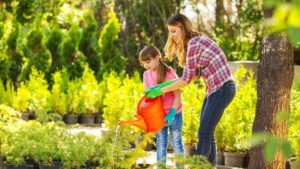 There are three things every garden needs: sun, soil, and especially, water. National Water a Flower Day (celebrated May 30) recognizes the special importance of gardens. Caring for green spaces connects us to nature, improves our health, and raises the value of our homes.
There are three things every garden needs: sun, soil, and especially, water. National Water a Flower Day (celebrated May 30) recognizes the special importance of gardens. Caring for green spaces connects us to nature, improves our health, and raises the value of our homes.
Most people water their garden with a hose. It’s simple and convenient, but unfortunately not an option for every homeowner. Even with an outside faucet, it’s not always the best way to care for plants. Watering with a hose:
- Wastes Water. Hoses have an average flow rate of 9-17 gallons per minute. Half an hour of watering, therefore, can use more than 500 gallons. To help conserve water, homeowners should use an adjustable nozzle to control flow.
- Encourages Weeds. By their nature, hoses distribute water widely over the ground. As a result, they nourish weeds as well as plants. Targeted watering takes longer, but helps weeds die on the vine.
- Leads to Overwatering. Plants have different water requirements. Some need lots, others very little. Hoses make it harder to give each plant exactly what it needs.
- Creates Runoff. Too much water can cause fertilizers and pesticides to drain into nearby lakes, rivers, and streams or soak into groundwater.
Thankfully, hoses aren’t the only way to water a garden. Alternative methods not only save water but are sometimes better for the plants as well.
Other Ways to Water Your Garden
While some areas (lawns, for instance) require hoses, most do not. There’s a host of cheaper alternatives that nourish plants and conserve water. Some even save time compared to spraying everything down with a hose.
- Watering Can. One of the oldest and simplest ways to water plants. Watering cans have the advantage of directing water directly onto roots, which minimizes weeds.
- Rose Waterers. Fitting a rose attachment to a watering can disperse water over a wider area. Rather than buy one, make one by poking holes in the top of a plastic jug.
- Drip Irrigators. Long tubes attached to a spigot deliver a small but steady stream of water. Drip irrigators prevent overwatering, minimize evaporation, and are enormously flexible. If they appear unsightly, they can be buried or covered over with mulch.
- Bottles & Clay Pot Reservoirs. A great solution for plants that need constant watering. Take an empty wine bottle, poke a hole in the top, fill it with water, then insert it into the ground next to the plant. The water will gradually dribble out throughout the day. Clay pots work just as well but take a bit more effort. First, dig a hole next to the plant. Then fit a cork into the bottom of a pot and fill it with water. Finally, place the pot in the hole and scoop dirt around it. In order to prevent evaporation, cover it with a plate or piece of hard plastic.
How to Water Gardens More Efficiently
For homeowners serious about conserving water, there are several ways to improve the effectiveness of watering techniques.
- Drought Resistant Plants. Homeowners in arid environments should focus on plants adapted to dry conditions such as lavender, autumn sage, and California poppies. Even in dry weather, they’ll stay green and vibrant.
- Lay Down Mulch. Sunlight’s pretty, but it dries out your soil. Spreading a layer of mulch over flower beds makes it easier for water to soak in and nourish plants. There are several types, but wood chips retain the most moisture.
- Water Less Often. Roots grow close to the surface when water is abundant. By watering less frequently, they’re forced to grow deeper in search of moisture. It not only makes plants more resilient but also stimulates microorganisms in the soil.
- Ceramic Pots. Pots allow excess water to leak out the bottom, which prevents overwatering. Place a dish underneath it to collect the excess. It creates a reservoir the plant can draw on throughout the day.
- Collect Rainwater. Rain barrels are an inexpensive way to collect and store water. They’re not hard to set up. A spout directs runoff from gutters into the barrel. A simple valve provides quick and easy access when needed.